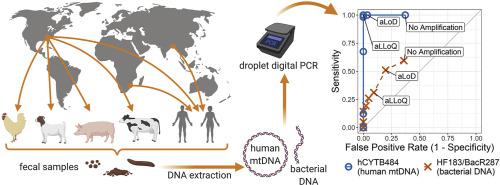Water Research ( IF 12.8 ) Pub Date : 2020-06-26 , DOI: 10.1016/j.watres.2020.116085 Kevin Zhu 1 , Brittany Suttner 1 , Amy Pickering 2 , Konstantinos T Konstantinidis 1 , Joe Brown 1

|
Human mitochondrial DNA provides a promising target for fecal source tracking because it is unique and intrinsic to humans. We developed a TaqMan chemistry assay, hCYTB484, targeting the cytochrome b gene of the human mitochondrial genome on a droplet digital PCR (ddPCR) platform and compared the performance of hCYTB484 with the HF183/BacR287 assay, a widely used assay targeting human-associated Bacteroides. For both assays, we defined the analytical limit of detection and analytical lower limit of quantification using frequency of detection and imprecision goals, respectively. We then established these analytical limits using empirical ddPCR data, presenting a novel approach to determining the analytical lower limit of quantification. We evaluated assay sensitivity using individual human feces from US, Bangladesh, and Mozambique and evaluated assay specificity using cow, pig, chicken, and goat samples collected from the US. To compare assay performance across a range of thresholds, we utilized receiver operating characteristic curves. The hCYTB484 marker was detected and quantifiable in 100% of the human feces from the 3 geographical distant regions whereas the HF183/BacR287 marker was detectable and quantifiable in 51% and 31% (respectively) of human feces samples. The hCYTB484 marker also was more specific (97%), having fewer detections in pig, chicken, and goat samples than the HF183/BacR287 marker (80%). The higher performance of the hCYTB484 marker in individual feces from geographically distant regions is desirable in the detection of fecal pollution from sources to which fewer individuals contribute, such as the non-sewered forms of sanitation (e.g. pit latrines and septic tanks) that serve most of Earth's population and carry the highest risk of exposure to fecal-oral pathogens.
中文翻译:

用于粪便来源跟踪的新型液滴数字PCR人mtDNA检测。
人类线粒体DNA为粪便来源追踪提供了一个有希望的目标,因为它是人类特有的并且是人类固有的。我们开发了一种TaqMan化学测定法hCYTB484,其在液滴数字PCR(ddPCR)平台上靶向人线粒体基因组的细胞色素b基因,并将hCYTB484与HF183 / BacR287测定法的性能进行了比较,HF183 / BacR287测定法是一种广泛使用的针对人类相关拟杆菌的测定法。对于这两种测定,我们分别使用检测频率和不精确目标定义了检测的分析极限和定量的分析下限。然后,我们使用经验性ddPCR数据建立了这些分析极限,提出了一种确定定量分析下限的新颖方法。我们使用来自美国,孟加拉国和莫桑比克的人类粪便评估了测定的敏感性,并使用了从美国收集的牛,猪,鸡和山羊样品评估了测定的特异性。为了比较各种阈值范围内的测定性能,我们利用了接收器的工作特性曲线。在3个地理遥远地区的100%人类粪便中检测到hCYTB484标记并对其进行了定量,而在51%和31%的人类粪便样品中HF183 / BacR287标记均被检测到并进行了定量。hCYTB484标记也具有更高的特异性(97%),与HF183 / BacR287标记(80%)相比,在猪,鸡和山羊样品中的检出率更低。hCYTB484标记在来自地理上较远地区的单个粪便中具有更高的性能,这对于检测粪便污染的来源较为理想,这些污染源是由较少的个体造成的,例如为大多数人提供服务的非下水道形式的卫生设施(例如坑式厕所和化粪池)人口中,粪便病原体暴露的风险最高。在猪,鸡和山羊样品中的检出率均低于HF183 / BacR287标记(80%)。hCYTB484标记在来自地理上较远地区的单个粪便中具有更高的性能,这对于检测粪便污染的来源较为理想,这些污染源是由较少的个体造成的,例如为大多数人提供服务的非下水道形式的卫生设施(例如坑式厕所和化粪池)人口中,粪便病原体暴露的风险最高。在猪,鸡和山羊样品中的检出率均低于HF183 / BacR287标记(80%)。hCYTB484标记在来自地理上较远地区的单个粪便中具有更高的性能,这对于检测粪便污染的来源较为理想,这些污染源是由较少的个体造成的,例如为大多数人提供服务的非下水道形式的卫生设施(例如坑式厕所和化粪池)人口中,粪便病原体暴露的风险最高。


























 京公网安备 11010802027423号
京公网安备 11010802027423号